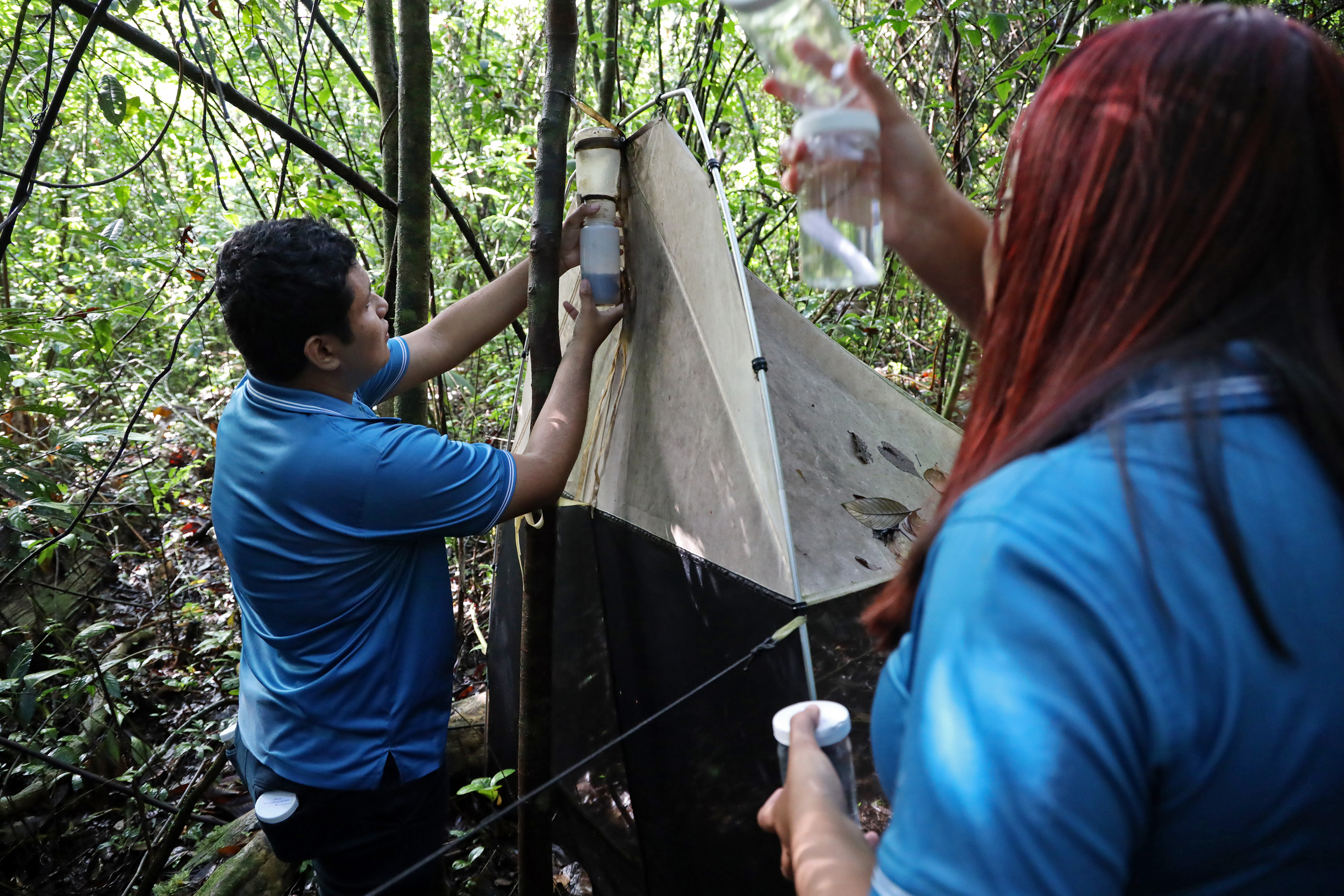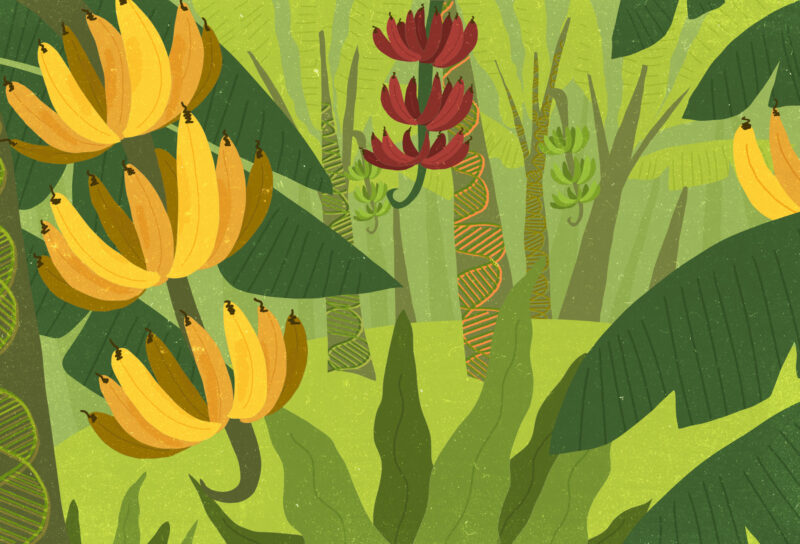“Will we discover a new species today?”
Across a smattering of small homes around Dos Rios de Upala, a rural settlement in northwestern Costa Rica, this thought propels a half-dozen high school students out of bed early every Tuesday morning. Animated by the tantalizing possibility of a new taxonomic discovery, they rush through breakfast and by seven o’clock are in the science lab of their open-air high school, the Liceo Dos Rios: enrollment, 74. They prepare, sticking identification labels on the lids of empty glass jars. By eight o’clock, they are striding purposefully across the school’s soccer field and toward a thick green curtain of tropical forest towering just beyond the far goal.
This particular November day is warm and humid. The grass glistens from an earlier drizzle, and the sky-blue polo shirts of the students’ uniforms seem to shine beneath a low ceiling of stormy clouds swirling overhead.
“We always watch where we put our feet.” This is Valeria, an amiable, earnest girl with auburn-streaked dark hair, who knows the risk of disturbing one of the venomous snakes that inhabit the region. She and two boys, Gabriel and Alejandro, are the leaders of the group, all 16 years old and in the 10th grade, the top level in Costa Rica’s high schools. As I walk alongside them through the grass they speak to me in Spanish, occasionally stealing a look up from snake watch to scan for monkeys that feed on the fruits of the big trees just beyond the end of the field.
There are no snakes or monkeys today — at least not yet — and as we enter the forest we are surrounded by the churning hum of cicadas and the soft patter of water dripping off the shadowed leaves above.
The students seem giddy with the hope of a personal discovery, but they also exude a quiet confidence that here, in the remote rainforests of Costa Rica’s Caribbean slope, they may be part of something far grander, a cusp of history for their nation and the world.
A few paces in, we stop in front of what looks like a modified pup tent strung from the waists of nearby trees. The tent is a Malaise trap, a scientific tool invented in 1934 by the Swedish entomologist René Malaise, now used around the world to capture arthropods, a phylum of animals that includes insects, spiders, mites, and centipedes and which represents more than 80 percent of all multicellular terrestrial species on the planet. The trap funnels these creatures from a large opening to the opposite, closed end of the tent. Once inside, they seek escape, moving up to a high peak. A small opening at the top of the peak plops them into a plastic bottle filled with 95 percent ethanol, which quickly kills and preserves them. The preserved contents are fetched weekly by the students.
Gabriel, short, wiry, and self-assured, reaches up to unfasten the plastic bottle, then pours the contents into a labeled glass jar proffered by Alejandro.
“This trap collects the most insects,” says a proud Gabriel, whom the other students call “El Dueńo,” the owner. Gabriel helped set up this particular Malaise trap back in March, clearing the brush around it with a machete, revealing a (thankfully) sleepy terciopelo, one of the most fearsome snakes in Costa Rica.
Alejandro, who is tall, lean, and pensive, refills the plastic collection bottle with fresh ethanol and reattaches it to the trap, where it will remain for another week, capturing another opportunistic sample of the diverse life teeming in the forest. “We live together with the forest around us, so it’s important to know what’s in it,” he says. Every week, the prospect of a true discovery awaits, floating like wonders suspended in the ethanol. Alejandro pauses, contemplating. “Every time you look, it’s like you could find a new word.”
This is BioAlfa, short for bioalfabetización, a new national project to identify the estimated 1 million-plus species of animals and plants in Costa Rica’s forests and waterways. Translating to “bioliteracy,” the project is an unprecedented effort to bring together genetics, natural history, and other useful information about each of these species into an easily accessible digital public library of nature.
In the race to find solutions to the global loss of biodiversity, Costa Rica, a democratic nation about the size of West Virginia, once again finds itself on the front lines. It contains 4 percent of the world’s biodiversity and has at least one-fourth of its territory covered in natural forest.
Conservationists here have worked for decades to answer the big question of the species extinction crisis: how can the inhabitants of a developing country get to know and care enough about their parks and reserves to want to shield them from destructive economic forces?
Answer: Help them discover and learn what’s in it.
BioAlfa is one way, representing the first time a tropical country has committed to fully cataloging all of its multicellular biodiversity. And it is inspiring a new generation of Costa Ricans to engage with the living resources around them.
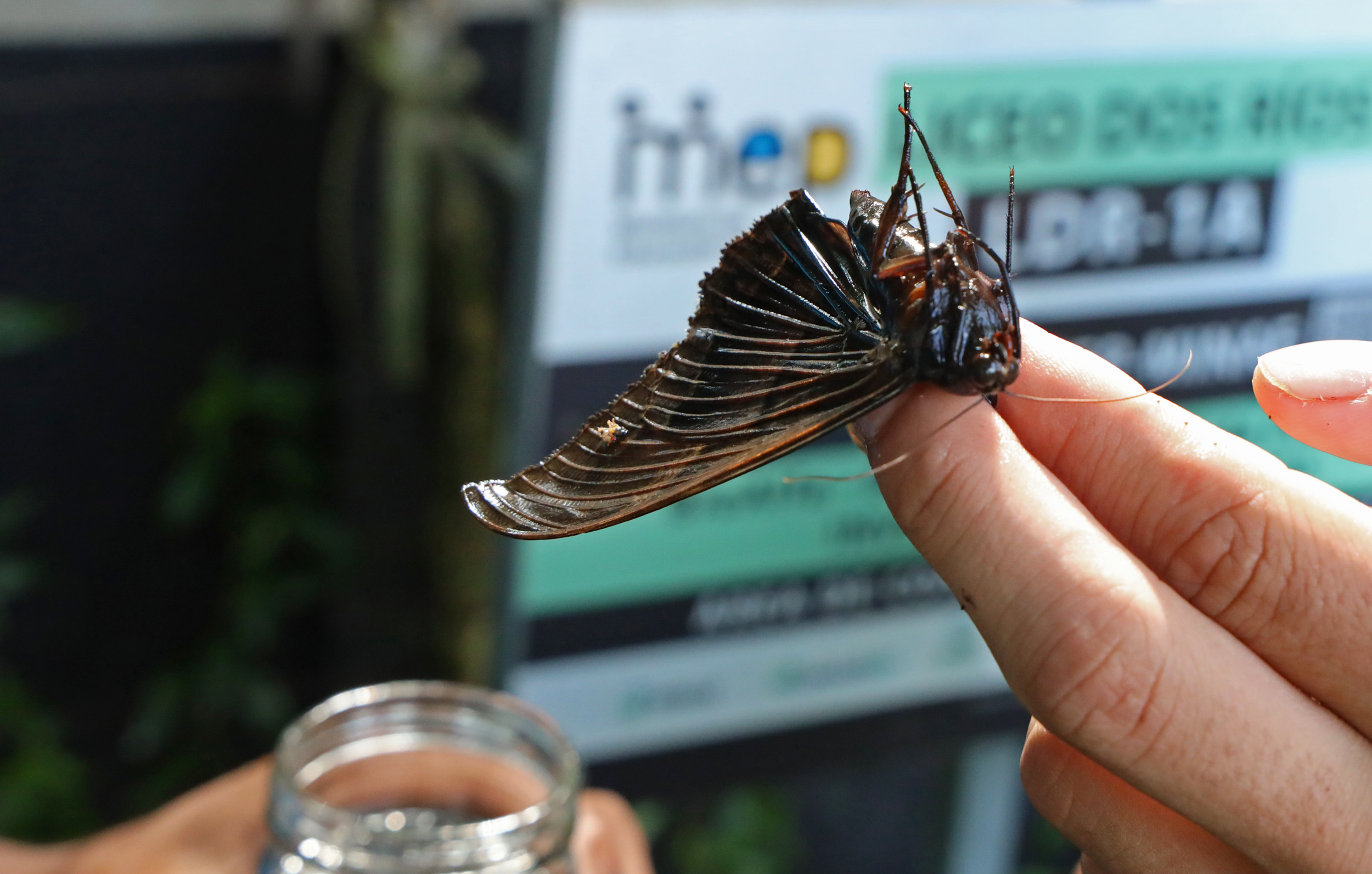
Into the Tropical Ecology Idea Factory
The students turn away from the Malaise trap and slip, catlike, through a barbed wire fence. I follow, along with my friend J.B., a celebrated photojournalist, and Roberto Fernández and Eugenie Phillips-Rodríguez, two Costa Rican biologists with the Guanacaste Dry Forest Conservation Fund, also known as GDFCF. (It’s just us today: the Dos Rios teachers involved in the trapping project are away at a conference elsewhere in the country.)
J.B. and I are both experienced field journalists, but we’re in our 70s and not as limber as we used to be, so when we can’t bend quite enough to avoid the barbs, the students return to spread the wires apart for us. Thankfully, they refrain from laughing.
Gabriel agily leads the students ahead down a narrow path of spongy brown leaves straddled by tree roots and draped by branches and dangling vines that brush their shoulders, leaving dark wet spots on their polos.
Here, in Sector San Cristóbal of Área de Conservación Guanacaste, or ACG, we are walking through the scene of yet another myth-busting brainchild of Daniel Janzen, one of the world’s foremost tropical ecologists — engineer of a massive, multi-decade forest restoration that experts said couldn’t be done. Janzen recently retired from the University of Pennsylvania but still toils in ACG, a United Nations Natural World Heritage Site.
Now Janzen and his local colleagues have a plan to persuade Costa Rican society of the value of nature by enabling them to read it. “Every Costa Rican species is a book, nearly all unread yet readable if named, opened, and in hand,” Janzen says. Their goal: enable Costa Rica’s residents to find all the unnamed books in these precious libraries of biodiversity, name and catalog them, read them, tell their stories, and make those stories broadly available to the public. It is perhaps the latest effort to head off what Janzen and others warned beginning in the 1970s and ‘80s: that the rapid destruction of tropical forests around the world was tantamount to burning its libraries.
The roots of ACG first took hold in 1971, when the Costa Rican government established Santa Rosa National Park, one of the nation’s early parks, which surrounded a historic battlefield. Six years later, Janzen, who had already conducted tropical field research on several continents, set up shop in the dry forests of Santa Rosa.
He was renowned for his doctoral research in southern Mexico, while a researcher at Berkeley, demonstrating the coevolutionary relationship between the acacia trees that house and feed stinging ants, which in turn protect the trees from threats. Now he commenced his work in Santa Rosa with “more energy than ten locomotives,” as one scientist put it, refusing to specialize as he strove to gain an understanding of Costa Rica’s astounding biodiversity. He observed, collected, and cataloged organisms across dry forest, cloud forest, and rainforest habitats, writing about their complex interactions. His focus ranged from insect migration across volcanoes as seasons change to the importance of seed dispersal by birds, mammals, and wind in forest restoration.
Soon joining him in his research and conservation efforts was fellow Penn biologist (and his future wife) Winifred Hallwachs, whom Janzen credits with crucial intellectual insights, although she prefers to stay in the public background. He also emphasizes the key role played by countless Costa Ricans in what was to come.
Among his hundreds of publications was a seminal 1983 co-edited book, “Costa Rican Natural History,” an 816-page collection of essays and short accounts of flora and fauna written by him and more than 150 other scientists and painstakingly edited by Janzen and Hallwachs. For these and other works, the Royal Swedish Academy of Sciences awarded him the Crafoord Prize, considered the Nobel of ecology, for influencing modern tropical field biology theory and practice. Five years later, he won a MacArthur genius fellowship for his “exceptional creativity and independent thinking” and work as “a pioneer in restoration ecology of tropical forests.”
Janzen began advocating for a large-scale taxonomic drive to document tropical biodiversity, writing that most conservationists didn’t realize “how quickly the tropics is sliding down the craw of human consumption.” He called on the U.S. Department of Agriculture and the Smithsonian’s U.S. National Museum to commence a “megalomanic push” to collect, identify, and store all the insect species in the New World tropics. The bureaucracy responded as best it could: crickets, and not the kind conservationists were looking for.
Back in Costa Rica, Janzen trained local talent in the art of collecting crickets and moths and other creatures that crawled the forest’s branches. A key was to bag not only the insect, but the leaf or branch that it clung to, and ate, or reproduced on, or used for specialized shelter. This practice revealed how the organisms of the forest were inextricably linked to other species within their particular ecosystems, showing how human destruction in one area, such as burning or logging, could harm species that spent part of their year in far distant places, too.
“To see it clearly,” Janzen wrote, “you have to both live in it and be an ecologist excruciatingly finely tuned to how little perturbation it takes to send an ecological interaction into delirious orbit.” In other words, preserving an ecosystem meant more than just preserving its species; it meant preserving the interactions among species and their ecosystems, and preserving adjacent ecosystems across a larger landscape.
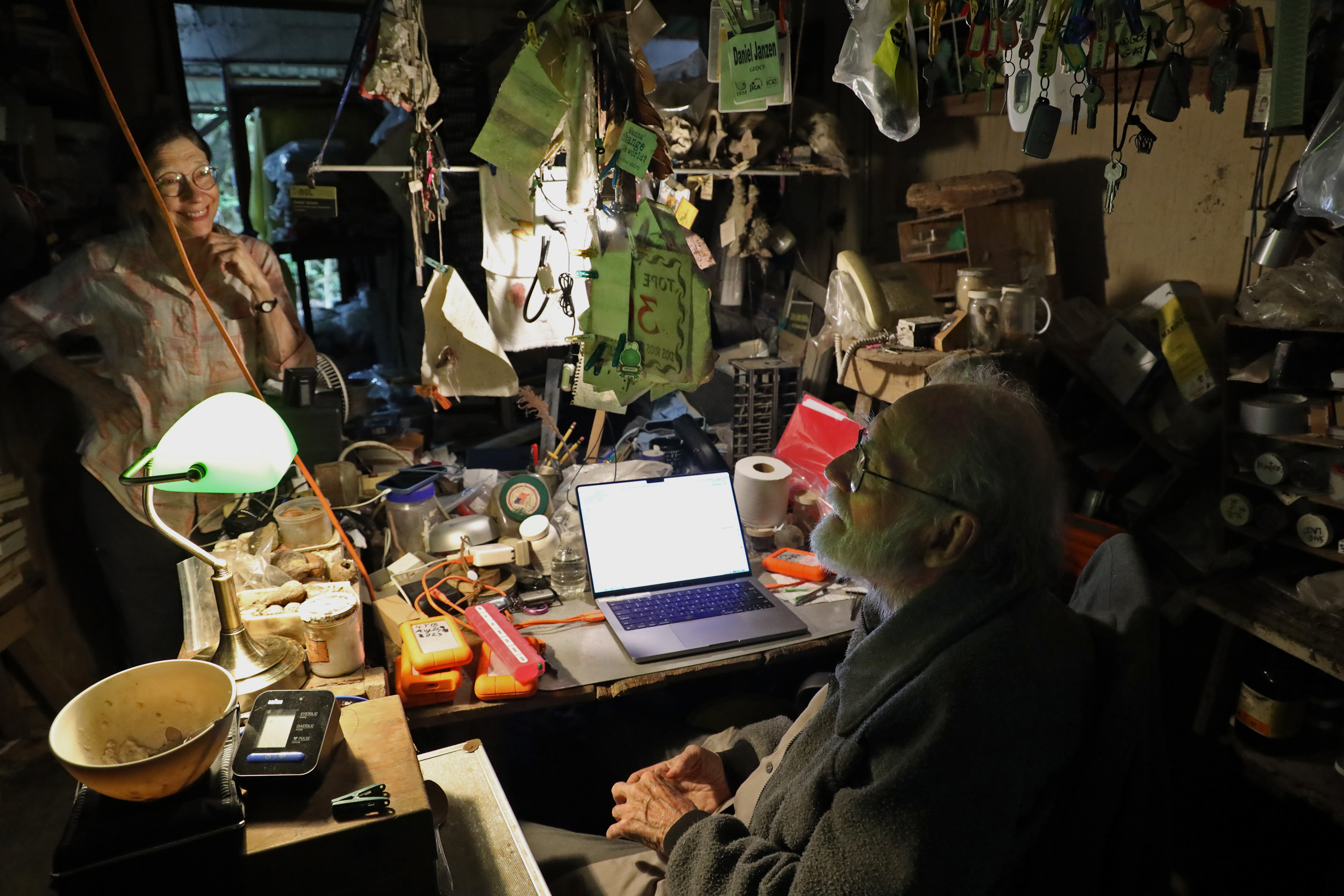
In the early 1980s, although still based at Santa Rosa, Janzen was assigned by the government to study a problem at another rainforest national park where he and Hallwachs had previously worked, Corcovado, in southwestern Costa Rica. The park had been invaded by 1,500 amateur gold miners whose dynamiting and other crude methods devasted its forests, animals, and streams. He responded in typical Janzen fashion, plying the park’s muddy paths to listen to the stories of the miners, gathering them in a local village hall to explain the damage, and listening to their concerns about just how they would leave. They were desperate to make a living, and the main value they saw in the park was in its scattered flakes of gold.
Yet, they were deeply interested in the plants and animals of the forest, an inclination that runs deep in Costa Rican culture. They were “highly rational and capable of learning about the impact they had on the park and the park’s value to them and the country,” Janzen later wrote. Many of them wanted to save the forests and the organisms in them, but they had to feed their families.
Armed government guards eventually persuaded them to depart, without bloodshed, but the big lesson was clear for Janzen. The way to protect parks was not with “guns and gold badges,” as he put it, but by “biocultural restoration,” a process of “embedding the parks as firmly in the hearts and minds of Costa Ricans as are its schools and churches.”
Conservationists should view national parks “not as fortresses but rather as a community resource, a local factory,” he says. A tapir, jaguar, or any other animal could be saved in two ways. “Assign it a 24-hour park guard with a submachine gun or expend the same amount of energy rendering it immoral to serve tapir meat to your family and neighbors.”
Preserving an ecosystem meant more than just preserving its species; it meant preserving the interactions among species and their ecosystems, and preserving adjacent ecosystems across a larger landscape.
Investing in People
Deeper inside the forest, the Dos Rios students arrive at the second Malaise trap. It’s dark here, and quiet, except for the diminished hum of the cicadas.
“The insects aren’t as abundant since there’s not as much light,” Gabriel explains, detaching the trap’s plastic bottle. El Dueńo is something of a hero to the group because he is the only one to visit the traps every Tuesday, even on holidays and school breaks. He loves the routine, the specifics of it, the discipline. On such days he rides his small motorcycle in from the family’s cattle ranch outside of town.
Vibrant and sociable, Gabriel is used to seeing tapirs and monkeys in the forest near home, but since getting involved in BioAlfa he’s gained a greater appreciation for insects and other smaller creatures in nature and wants to know more about life in the forest. He doesn’t know yet what he will do after graduation.
Gabriel pours the bottle contents into a glass jar held by Alejandro, who stands straight and proper. Alejandro is the only one in the group who has the top button of his polo shirt fastened. His father is a businessman in Liberia, the provincial capital. He is unsure of his career path, too. He’s happy that one of his younger brothers is desperately looking forward to participating in the project next year. Alejandro knows his brother will thrive as they work to unlock the intriguing story each creature has to tell.
Collection complete, the students turn, stepping lightly through the dense forest, edging watchfully toward the third and final trap.
After his encounter with the miners, Janzen put the biocultural restoration concept to work. He knew that to protect the newly burgeoning Santa Rosa, the communities surrounding it would need to understand its value to them as a biodiversity resource.
He ensured that he and his Costa Rican colleagues who developed the park’s infrastructure invested in the communities around the protected area by involving them in the restoration. They hired resident workers to help with research projects, engage with tourists, patrol for poachers, and fight fires, a process described in my book on the first decades of the ACG.
They started a biological education program for kids in the local schools, through which students around Guanacaste Province were brought to Santa Rosa to learn about nature in the park. Over the next four decades, the Programa de Educación Biológica reached more than 2,000 students per year from nearly fifty schools.
To support the effort, Janzen set out across North America and Europe to raise more than $100 million for what soon officially became ACG, which now consists of more than 350 former private properties. Today, the original 10,800 hectares of Santa Rosa National Park is just a small part of the 169,000-hectare ACG, comprising some 2 percent of Costa Rica. The conservation area stretches uninterrupted across four of the five main ecosystems of the tropics: marine, dry forest, cloud forest, and rainforest. It is the only conserved transect of its type in the New World and contains an estimated 2.6 percent of global biodiversity, about 500,000 species — more than in the continental United States and Canada, combined.
Innovations continued over the years, including the creation of a corps of “parataxonmists.” Akin to paramedics and paralegals, these are a group of dozens of resident rural nonscientists trained to collect and gather data on animals and plants, no advanced degree required.
Then, in 2003, DNA barcoding appeared.
A new gene-evaluation and use technology developed by Paul Hebert, director of the Centre for Biodiversity Genomics and professor at the University of Guelph in Canada, DNA barcoding promised to accelerate the biocultural restoration concept.
Through his work on mitochondrial DNA fragments in animal tissue, Hebert and his colleagues found that a portion of a gene known as cytochrome c oxidase I (COI) could be used to determine which species a sample belonged to, whether the species was known or unknown, by comparing that with a known gene source library. In a relatively small (generally 400- to 800- base pairs) segment of the COI gene, essentially every species has a unique DNA barcode. The Guelph analysis process was quick and accurate, and it far surpassed the previous gold standard of taxonomic identification in which highly trained scientists determined species by meticulously studying and comparing the minutiae of an individual specimen’s physical appearance with others.
Traditional taxonomists rejected barcoding at first, seeing it as an unproven method and a threat to their exacting profession, and Hebert stood virtually alone as an advocate. However, Janzen and Hallwachs jumped on it, becoming prominent boosters and offering ACG as an early and large-scale user. Specimens collected by parataxonomists were stored in deep freezers at Santa Rosa and small pieces of tissue — one leg from an insect, for example — eventually made their way up to Guelph for analysis by plane, sometimes sandwiched in the Penn biologists’ luggage, all with proper permits, of course.
Two decades later, barcoding is widely accepted internationally in both academic taxonomy and the commercial world, and ACG, already known as a flagship of biodiversity studies, is the most heavily barcoded site in the world. To date, the Guelph genomic center has barcoded more than a 3 million ACG insects consisting of some 145,000 species. In some cases, what was thought to be one species based on physical appearance was actually found by barcoding to be several distinct species, sometimes with distinct behaviors and habitat preferences.
ACG has provided “an unrivaled test bed for the capacity of DNA-based identification systems to advance our understanding of biodiversity and our capability to manage it,” says Hebert. “There is absolutely no place on the planet that can deliver the kind of datasets that ACG can deliver and has delivered for decades. It is unique, and it’s critically important to advancing understanding of global biodiversity patterns.”
Janzen hopes that the evolving speed and decreasing cost of DNA barcoding will one day lead to a pocket-size, personal reusable “barcoder” that’s cheap enough for anyone to afford and use. In this world, anyone with an interest in nature around them could have what Janzen calls a “magic comb,” like the “tricorder” that millions saw Spock whip out on Star Trek to analyze some element of an unfamiliar environment.
Portable sequencing is already making enormous strides in device miniaturization and cost, and with some more development, anyone could use a handheld sequencer to identify the bugs and plants around them. Does the mosquito that just bit you have a history in the literature of transmitting disease? In the future, maybe you could check it yourself, using your trusty handheld barcoder. For now, however, because of the need to send their specimens to Guelph to determine their identities, the Dos Rios students must patiently wait for any “eureka moments” they may experience.
BioAlfa and a Presidential Decree
On the last leg of their hike, the students reach the bright edge of the forest, west of where they originally entered from the soccer field earlier this morning. Here stands a third and final Malaise trap, still shaded by trees but with a clear view of the school.
This time it is Valeria, whose father runs a small cattle farm outside of town, who removes the bottle with the treasure trove. She accepts that the forest can be dangerous, with its pumas and snakes, but it is also resplendent. She’s fascinated with insects, especially butterflies, and loves learning about them. On previous visits, the traps have revealed butterflies she’s never seen before.
Valeria smiles gleefully as she prepares to pour the body-laden liquid into yet another glass jar.
Surprise! Her smile and eyes get even wider.
Something large floats at the top of the mixture: dark, with four legs and a long tail. It is stuck in the mouth of the plastic bottle, and at first we can’t tell whether it’s dead or alive. The students gather around closely but cautiously, except for Gabriel, who steps up, reaches in, and with thumb and forefinger pulls out a helmet lizard, slightly bulkier than a ballpoint pen. It is unusual, though not unprecedented, to find something other than an insect in the bottle.
Valeria, focusing intently, pours the rest of the mixture into the glass jar, and the group strides back to the school across an open field, chatting about the possibilities of the mysteries they have collected inside their bottles. A mild sense of euphoria surrounds them, perhaps a mixture of relief that their excursion produced no snakes. But there is also a sense of accomplishment, the knowledge that they are part of something important, like a slightly more enlightened world.
As DNA barcoding flourished in ACG, Janzen and Hallwachs came up with another radical idea: why not leverage its power to build a public library of life for the entire country? Enter BioAlfa.
Funds would be required for equipment, technical personnel, and the cost of barcoding, which had dropped to around $3 per specimen. (Now it is just $1). But lots of labor — “sweat equity,” Janzen calls it — was available to collect from Malaise traps set up around Costa Rica in wild areas, the agroscape, and towns. The traps would be relatively easy to monitor weekly by park staff and trained volunteers — private landowners, NGO personnel, and high school and university students. Thus, the current biodiversity survey army, consisting of a few platoons of semi-specialist parataxonomists and specialist Ph.D. taxonomists, would add a sizable militia of moderately prepared non-experts willing to earn that sweat equity.
Eventually barcoding technology could advance to the point where Costa Rica would establish its own facility, giving the rest of Latin America an example of how to develop its nascent barcoding capacity. Meanwhile, professional and citizen scientists would continue gathering information on each species, whether through field observations or other kinds of research, such as that assembled in iNaturalist, an online network where people share knowledge about biodiversity.
In this new BioAlfa library of life, the name of each species would become its “book” title. As naturalists have been doing since Linnaeus, only faster, information would be added to each book— the “when,” “where,” and under what conditions each was collected. Also added, whether already published in the scientific literature or as the result of new studies, would be “why” the organism may be important, “what” it does, and “how” it connects with other parts of its ecosystem, including us. The information in each book would continually grow as scientists published more detailed studies. You can imagine the plot lines emerging in each opus of life, the themes developing, the cast of characters mingling, the conflicts emerging. All unfolding in bits and pieces over time, a serial novel that we can all appreciate if we can just maintain the wild sites in which it can exist.
Armed with such knowledge, policymakers and the general public would be in a better position to act with regard to the world around them. Non-scientists curious about the beauty and complexity of the natural heritage around them could use it, as could conservationists concerned about wildland management, entrepreneurs exploring ideas for sustainable development, farmers worried about new pests, medical experts tracking the spread of disease.
“Like learning to read,” Janzen says, “the next generation will build on that technology and discovery process, just as we learn from libraries, the internet, documents, and all the other things we do with literacy.” Now, stewards of biodiversity could be “welcomed to society’s negotiating table,” as he puts it, as are proponents of schools, hospitals, highways, airports, and libraries.
That was the idea when, in January 2019, the GDFCF hired Phillips and Fernández, whom Janzen calls “a technical-biopolitical team of seasoned biodiversity managers.” Both are biologists with experience in the field and in the halls of the Costa Rican government bureaucracy.
At a June 2019 ceremony in the capital city of San José, President Carlos Alvarado Quesada signed a decree declaring BioAlfa in the “national interest.” The decree directed public agencies, private institutions, and other parties to collaborate on the project’s behalf, saying it was needed to improve the nation’s responses to climate change impacts and prevent “the loss of social memory about biodiversity.” Costa Rica was “positioned globally” to increase knowledge about its “natural and cultural heritage” and to search for “chemical and genetic compounds that could be used by the biotechnology, pharmaceutical, agricultural, cosmetics, and other industries.”
The first year of nation-wide collecting produced a million insect samples, all of which went on to Guelph. Janzen estimates they comprise 160,000 species.
Data collected already has proven useful, solving a dispute between conservationists and the Costa Rican national electric company over where to site a geothermal production drilling platform and how far into the surrounding forests there is an impact, and in other studies revealing massive shifts in the areas across which species move in response to climate disruption.
Janzen and colleagues hoped the BioAlfa idea would spread by example, like other conservation concepts they have incubated at ACG, especially in the global South. It has already begun to. Several biologists, commercial executives, and government officials from Colombia, a larger country with vastly more biodiversity, visited Santa Rosa for a week to learn firsthand about the project.
Then came the COVID collapse, right at the tail end of the Colombian visit.
With the virus crushing Costa Rica’s economy and closing national parks, and with donations stalled, many BioAlfa trapping sites were closed. And as the nation climbed out of the pandemic, Rodrigo Chaves Robles, elected president in 2022, has focused more on traditional venues for economic development, seeming less supportive of BioAlfa.
Through it all, however, collaboration has flourished among government ministries, ACG, GDFCF, and teachers and administrators at Dos Rios. Everyone realized the significance: if this pilot project worked at Dos Rios, it could go nationwide.
“I believe it’s important because this is nature. We may not understand it, but it exists. We need to learn about it.”
On March 14, 2023, BioAlfa was launched in a ceremony at the school, including a tour of the traps for government VIPs. Since then the students have marched out on their weekly hike to collect from the traps, record data, and place the samples in a small freezer in a corner of their science classroom.
High Hopes at Dos Rios
The students, J.B., and I gather back in the classroom to talk about their BioAlfa journey. At one point, a brief shower passes overhead, hitting the corrugated roof like a cascade of coins.
Alejandro carefully lines the bottles up on a lab bench with labels facing front and takes a picture with his phone to be uploaded. He places them in the small freezer. Eventually, the bottles from the first two traps, which contain the official BioAlfa specimens, will be transferred to Santa Rosa and later to Guelph for barcoding.
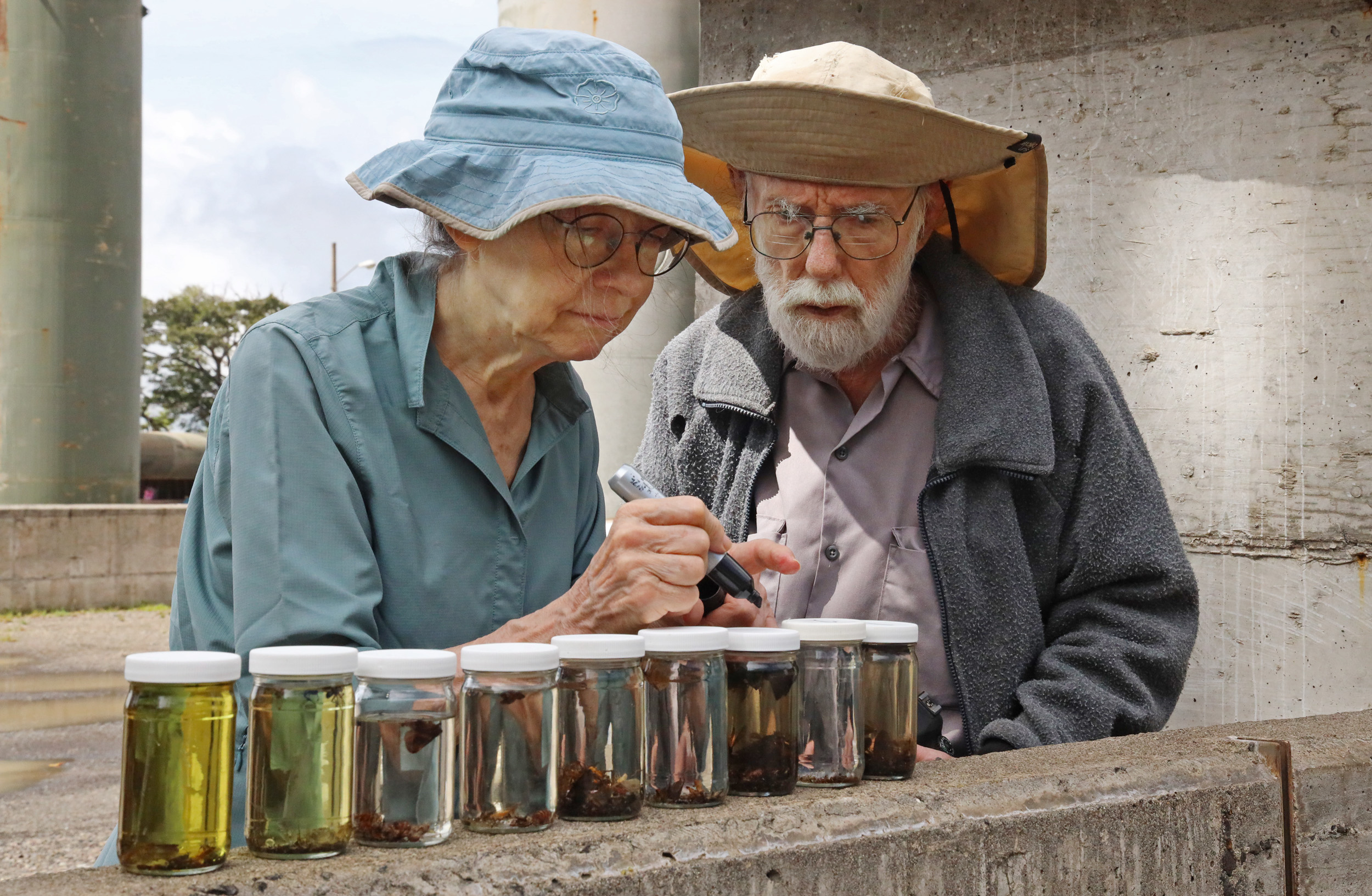
The contents from the third trap will be kept in the Dos Rios freezer and removed later for the students to study in their classroom. They enjoy working with the specimens, separating them by hand into taxonomic groups — moths and butterflies here, spiders there, flies, wasps, beetles.
They’re excited about the prospect of reading what these books have to tell them.
“To find so many insects in these traps is very interesting,” Alejandro says. “It really is like a library.”
He says it is “very important” that his group is going to find new species. Asked why, he smiles and hesitates, contemplating.
“It’s a profound question,” he says, pausing again and looking down at the floor for an answer. “I believe it’s important because this is nature. We may not understand it, but it exists. We need to learn about it.”
It strikes me how much his words resonate with something Janzen says about how we normally teach children to read the printed word in the first grade, thus enabling them to follow — for the rest of their lives — their own literate paths of exploration into any subject that may interest or benefit them.
I turn to Valeria, who hopes to become a teacher of young children and plans to make sure they have a full appreciation of the diversity and beauty of life in the forest. She repeats the team’s hope of knowing soon whether they have found new species, and whether they have truly contributed to the deeply human project of understanding the natural world. Her excitement is infectious, and it reminds me of the fascination and joys that drew me into writing about tropical conservation decades ago. BioAlfa has kindled that joy in her, too, and promises to do so in her future students.
I remind her of the tradition in taxonomy that the collector of a new species gets to name it, and that some of the creatures recently found by parataxonomists in ACG have been named in honor of everyone from cooks in ACG comedors (Apanteles irenecarrilloae and A. ivonnetranae) to former presidents of Costa Rica (Pseudapanteles josefigueresi and P. luisguillermosolisi). What would she want to name the as-yet unknown species she finds?
Valeria giggles at the question, not one she’s considered yet. She leans back in her chair, smiling widely at the thought, pondering.
“Maybe one name for each member of the team,” she says, finally, “because all of them participated.”
